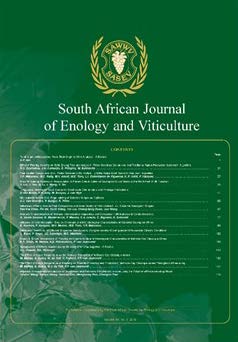Influence of Acetaldehyde Induction on Monomeric and Polymeric Polyphenols in Wine using the Polyphenol/Protein-binding Model
DOI:
https://doi.org/10.21548/39-1-2670Abstract
Polyphenols make a substantial contribution to the sensory properties of wine, and their evolution is affected by the acetaldehyde present during fermentation and ageing. In this work, five typical monomeric phenolic standards and three different polymeric flavanol fractions separated from wine were tested for polyphenol/protein binding by means of circular dichroism measurement and fluorescence spectrum assay in the presence or absence of acetaldehyde, and the formation of new oligomeric compounds linked by ethyl bridges was observed through HPLC-MS analyses. The results show that the protein-binding ability of these monomers was in the order of gallic acid > caffeic acid > quercetin > (+)-catechin > (-)-epicatechin, while acetaldehyde exerted a stronger effect on (+)-catechin and (-)-epicatechin monomers. Moreover, different wine fractions had different responses when reacted with proteins with the participation of acetaldehyde, while the polymeric proanthocyanidins produced the largest value (84.67%) of the salivary protein precipitation index and the strongest fluorescence-quenching effect.
Downloads
Downloads
Published
Issue
Section
License
A copyright form will be e-mailed to the corresponding author when the manuscript has been accepted for publication.
In principle, the Author agrees to the following when he/she signes the copyright agreement:
I hereby assign to the SOUTH AFRICAN SOCIETY FOR ENOLOGY AND VITICULTURE (SASEV) the copyright of the text, tables, figures, supplementary material, illustrations and other information (the Material) submitted with the manuscript to be published in SOUTH AFRICAN JOURNAL OF ENOLOGY AND VITICULTURE (SAJEV) (the "Article"). The copyright becomes effective from the date the Article has been accepted for publication in SAJEV.
This is an open access journal, and the authors and journal should be properly acknowledged, when works are cited.
Author's may use the publishers version for teaching purposes, in books, theses, dissertations, conferences and conference papers.
A copy of the authors' publishers version may also be hosted on the following websites:
- Non-commercial personal webpage or blog.
- Institutional webpage.
- Authors Institutional Repository.
The following notice should accompany such a posting on the website: This is an electronic version of an article published in SAJEV, Volume XXX, number XXX, pages XXX - XXX, DOI. Authors should also supply a hyperlink to the original paper or indicate where the original paper (www.journals.ac.za/index.php/sajev/) may be found.
Authors publishers version, affiliated with the Stellenbosch University will be automatically deposited in the University's Institutional Repository SUNScholar.
Articles as a whole, may not be re-published with another journal.
The following license applies:
Attribution CC BY-NC-ND 4.0

